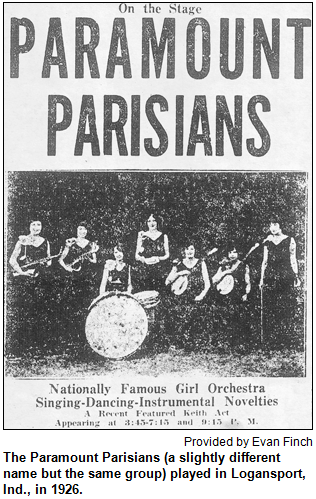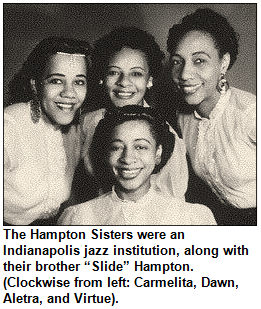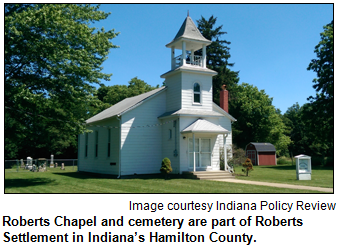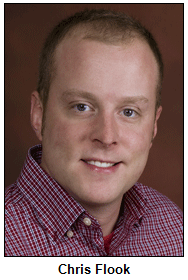Saturdays, noon to 1 p.m. ET on WICR 88.7 FM.
Or listen live from anywhere on WICR
Online!
Saturdays, noon to 1 p.m. ET on WICR 88.7 FM.
Or listen live from anywhere on WICR
Online!
Aug. 9 show
|
Even though they became nationally known during the 1920s as The Parisian Redheads, many of the band members were not red-haired - and, rather than Paris, they were based in Indiana.
In the 1930s, the all-female orchestra/dance band, which was promoted as "America's Greatest Girl Band," became known as The Fourteen Bricktops.
 The colorful history of the now-forgotten novelty band - which was based in Indianapolis, with a pianist born in the eastern Indiana town of Portland, a saxophonist from Elwood, a harpist from Richmond and other Hoosier "lady musicians" - will be the focus of our show. Nelson will be joined in studio by Evan Finch, an Indy-based advertising copywriter who has extensively researched The Parisian Redheads and other all-female orchestras.
The colorful history of the now-forgotten novelty band - which was based in Indianapolis, with a pianist born in the eastern Indiana town of Portland, a saxophonist from Elwood, a harpist from Richmond and other Hoosier "lady musicians" - will be the focus of our show. Nelson will be joined in studio by Evan Finch, an Indy-based advertising copywriter who has extensively researched The Parisian Redheads and other all-female orchestras.
"So-called 'ladies' orchestras had existed since the late 19th century due to the fact that male orchestras rarely hired female musicians," Evan notes in an article in the upcoming summer issue of Traces of Indiana and Midwestern History magazine. It's the popular magazine published by the Indiana Historical Society.
"As a result, women formed their own groups."
However, the impresarios behind The Parisian Redheads were two men, Charles Green and Harry Z. Freeman of Indianapolis, both of whom had experiences with organizing musical programs on the Chautauqua circuit. That well-known cultural circuit also had provided opportunities for many of The Parisian Redheads, several of whom were classically trained musicians, according to Evan's article.
"By the end of 1926, the group had become a local sensation," Evan writes. "In Indianapolis alone, within a space of four weeks, the Parisians played a reception forQueen Marie of Romania, opened the city's Marott Hotel and graced the stage of the Circle Theatre."
 Of the original Redheads, only pianist/singer Martha Tripper (a Portland native who later moved to Kokomo) was a natural redhead, Evan reports.
Of the original Redheads, only pianist/singer Martha Tripper (a Portland native who later moved to Kokomo) was a natural redhead, Evan reports.
"The other women were required either to dye their hair or wear red wigs when appearing in public. In the name of success, the musicians went along with the gimmick, although not always happily."
The Redheads expanded to a 13-piece orchestra in 1927 and attained national success. According to Evan, the performers eventually included a "Mistress of Ceremonies," a woman who dressed in a man's tuxedo and "sang, danced, conducted and otherwise functioned as the band's public face."
Some fun facts:
During the show, we expect to feature some musical interludes to give listeners a flavor of the Redheads (Bricktops) in performance.
Evan and Nelson also will share info about other all-female musical groups from Indiana. They have included the Hampton Sisters, who went, as the Indianapolis Star once put it, "from a child act to jazz legends."
The Hampton Sisters included pianist Aletra Hampton and bassist Virtue Hampton Whitted, who were 92 and 84 years old, respectively, when they died just months apart in 2007.  The group also included, at various times, two other Hampton sisters, Carmelita and Dawn.
The group also included, at various times, two other Hampton sisters, Carmelita and Dawn.
Group members also changed over the years with The Parisian Redheads-turned-Fourteen Bricktops (also known by other names, such as the Paramount Parisians, early on).
Even though the Bricktops broke up in the 1930s, some of the musicians enjoyed flourishing careers long afterward. Bricktop member Ruth Hutchins Thrasher became, as Evan puts it, "a valued member of the Indianapolis Symphony Orchestra - and played several different instruments for them over the course of four decades."
Why the emphasis (or insistence) on red hair?
"In addition to adding an extra layer of novelty, red hair gave the band a visual identity - and a hair color associated with free-spiritedness seems in tune with the Jazz Age," Evan writes in his upcoming Traces article.
He notes that, as the years passed, dozens of women musicians from across the country joined the band. But the group always had Indiana musicians, including Bobbie Greiss, a singer-dancer who grew up in Indianapolis and was recruited as the group's conductor. Trumpet player Lillian Evans was a native of Dublin in Wayne County, while another trumpeter, Alice Miller, attended Tech High School in Indy.
 Other members of the Parisians (or of the Bricktops) included saxophonist Bernice Lobdell of Huntington; accordionist Jeane Brown of Greencastle, and saxophonist Marietta Gift of Converse.
Other members of the Parisians (or of the Bricktops) included saxophonist Bernice Lobdell of Huntington; accordionist Jeane Brown of Greencastle, and saxophonist Marietta Gift of Converse.
In 1929, the band played the Palace in New York City and shared a bill with the famous Marx Brothers. As the vaudeville circuit declined, the Bricktops transformed into a dance band.
"The success of the Parisian Redheads and the Fourteen Bricktops proved that a band of women could compete successfully with men, both in terms of performance and financial reward," Evan writes.
He adds: "In the many years since the Bricktops' dissolution, opportunities for female musicians have improved. In 2010, it was estimated that the membership of America's top 15 orchestras - once almost exclusively male - had become 35 percent female."
To learn more, Evan recommends:
 One of the country's most popular bandleaders during the 1930s and '40s was a native of Linton, Ind. He grew up in the town in the far-western part of the Hoosier state, then enjoyed great success at nightclubs during the Big Band era.
One of the country's most popular bandleaders during the 1930s and '40s was a native of Linton, Ind. He grew up in the town in the far-western part of the Hoosier state, then enjoyed great success at nightclubs during the Big Band era.
The native Hoosier also was a hit on radio as the sidekick to comedian Jack Benny during the 1930s and '40s. Eventually, the bandleader starred in his own radio show with his wife, a glamorous movie star. He also appeared in more than a dozen Hollywood films, often playing a character like himself.
But his best-known connection to the movies may have been serving as the voice of an animal in a Disney cartoon movie. The bandleader died in 1995 at age 91.
Question: Who was he?
The call-in number is (317) 788-3314. Please do not call into the show until you hear Nelson pose the question on the air, and please do not try to win the prize if you have won any other prize on WICR during the last two months.
The prize pack includes two tickets to Beef & Boards Dinner Theatre and two passes to the Indianapolis Zoo, courtesy of Visit Indy, and four passes to the Indiana Experience, courtesy of the Indiana Historical Society.
 Guest Roadtripper Kisha Tandy, a curator at the Indiana State Museum, suggests a Roadtrip to Roberts Settlement, which once was a flourishing farm community of African-American pioneers from North Carolina who moved north to make their home in Jackson Township in Hamilton County.
Guest Roadtripper Kisha Tandy, a curator at the Indiana State Museum, suggests a Roadtrip to Roberts Settlement, which once was a flourishing farm community of African-American pioneers from North Carolina who moved north to make their home in Jackson Township in Hamilton County.
The history of Roberts Settlement sheds light on a group of individuals who owned land and established communities in Indiana before 1850.
The first residents to Roberts arrived in 1835 as free blacks. The settlement included homesteads and a school and church. Descendants continue to meet annually on July 4th for the Roberts Settlement Annual Homecoming to celebrate their family and heritage. And one always can stop by to look at the Roberts Chapel Church and Cemetery.
Kisha also recommends the book Southern Seed, Northern Soil (IU Press, 2002) by Stephen Vincent about African-American farming communities in the Midwest. She also reports that a documentary has been made about the topic; learn more on Saturday's show.
Your Hoosier History Live! team,
Nelson Price, host and
creative director
Molly Head, producer, (317)
927-9101
Richard Sullivan, webmaster
and tech director
Pam Fraizer, graphic
designer
Garry Chilluffo, creative consultant
Joan Hostetler, Michele Goodrich, Jed Duvall, Dana Waddell, advisors
Please tell our sponsors that you appreciate their support: Bose McKinney & Evans LLP | Indiana Historical Society | Lucas Oil | Story Inn | The Fountain Square Theatre Building

 Acknowledgments to Monomedia, Visit
Indy, WICR-FM, Fraizer Designs, Heritage Photo & Research
Services, Derrick Lowhorn and many other individuals and organizations. We
are an independently produced program and are self-supporting through
organizational sponsorships and individual contributions. We do not receive any
government funding. Visit
our website to learn how you can support us financially. Also, see our Twitter feed and our
Facebook page for regular updates.
Acknowledgments to Monomedia, Visit
Indy, WICR-FM, Fraizer Designs, Heritage Photo & Research
Services, Derrick Lowhorn and many other individuals and organizations. We
are an independently produced program and are self-supporting through
organizational sponsorships and individual contributions. We do not receive any
government funding. Visit
our website to learn how you can support us financially. Also, see our Twitter feed and our
Facebook page for regular updates.
Aug. 16 show
"I think in Indiana, as in many places, it's only been in the last 30 to 40 years that we've chosen to look outside of myth ... to truly understand the first peoples who lived in our state."
That comment from a historian introduces a new documentary about the Lenape tribe of Native Americans. It's the tribe that was named Delaware Indians by white settlers.
 The Lenape lived in the woodlands of east central Indiana from the 1790s into the early 1820s; during that time, they founded villages or trading posts that evolved into towns, including Anderson, Muncie and Strawtown.
The Lenape lived in the woodlands of east central Indiana from the 1790s into the early 1820s; during that time, they founded villages or trading posts that evolved into towns, including Anderson, Muncie and Strawtown.
Under the terms of the Treaty of St. Mary's negotiated in 1818, the Lenape gave up their claims to Hoosier soil and, as part of what has been called a "forced migration," moved a few years later to Kansas.
Eventually, the Lenape were moved again, this time to Oklahoma, the tribe's home state in modern times.
Considering that the Lenape had lived in New York, New Jersey, Pennsylvania and Delaware for generations even before being relocated to the Indiana Territory, is it any wonder that one expert in the documentary calls them "possibly the most-moved group in American history"?
To explore the tribe's life on Hoosier soil and impact here, Nelson will be joined in studio by two guests:
 During the early 1800s, Lenape leaders in Indiana included Chief William Anderson, for whom the largest city in Madison County is named. The Lenape who moved to Kansas included Anderson's daughter, Mekinges, who became the first wife of frontier entrepreneur and fur trader William Conner, namesake of Conner Prairie. They had six children, all of whom moved with their mother to Kansas; Conner remained in Indiana, remarried (a white woman) and had more children with his second wife.
During the early 1800s, Lenape leaders in Indiana included Chief William Anderson, for whom the largest city in Madison County is named. The Lenape who moved to Kansas included Anderson's daughter, Mekinges, who became the first wife of frontier entrepreneur and fur trader William Conner, namesake of Conner Prairie. They had six children, all of whom moved with their mother to Kansas; Conner remained in Indiana, remarried (a white woman) and had more children with his second wife.
During one of the first Hoosier History Live! shows after our debut in January 2008, we explored some aspects of the Lenape (Delaware) tribe in a show about the publication of Long Journey Home (Indiana University Press, 2008). It's a book of oral histories and color photos put together by Indianapolis-based author Rita Kohn and photojournalist Jim Brown.
Learn more:
© 2014 Hoosier History Live! All rights reserved.
Hoosier History Live!
P.O. Box 44393
Indianapolis, IN 46244
(317) 927-9101